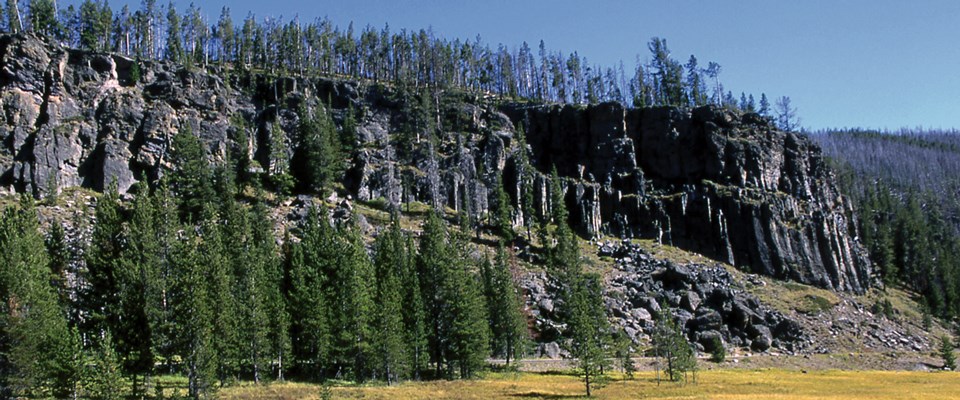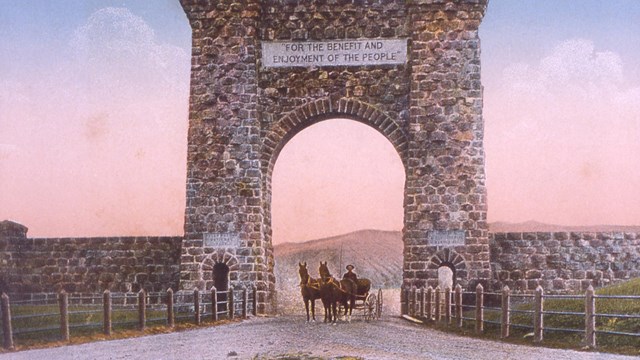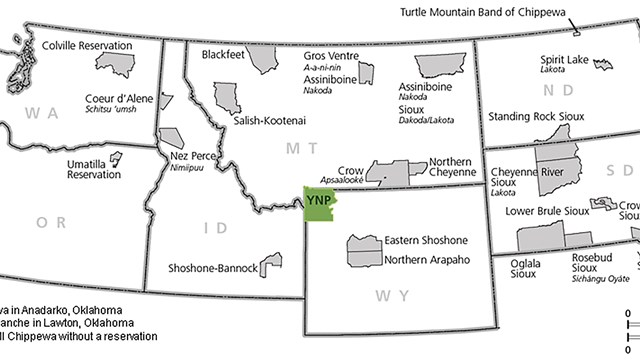|
The Tukudika, or Sheep Eater, Indians were a band of Mountain Shoshone that lived for thousands of years in the area that would become Yellowstone National Park. Throughout the park, archaeological sites reflect use of resources within this landscape by the Tukudika and other Native American tribes. The Name TukudikaTraditionally, Shoshone names were derived from places the bands traveled to or from foods they hunted or gathered. Tukudika (also Tukudyka’a, Tukadika) means “eaters of the mountain sheep.” The Tukudika lived in northwestern Wyoming, southwestern Montana, and eastern Idaho. Related bands bore the names “salmon eaters,” “elk eaters,” and “bison eaters.” Because the name Sheep Eater can appear to equate these Indians with the bighorn sheep itself, the term was once considered derogatory. The name Sheep Eater suggests a Shoshone social hierarchy on which the Tukudika occupied one of the lowest rungs: whereas other Shoshone bands were hunting and consuming the “grander” bison and elk, the Tukudika were hunting the “inferior,” elusive, mountain-dwelling bighorn sheep. Contemporary understanding of this name is more nuanced. The name does not signify that Tukudika ate only bighorn sheep; it means, simply, that the bighorn sheep was this group’s primary source of meat. Indeed, the Tukudika’s diet consisted of at least 50% plants, roots, nuts, and berries. However, the visceral connection between the Tukudika and the bighorn sheep is undeniable, for the Indians made their hunting bows from the same animal these weapons were designed to kill. 
NPS Tukudika CultureTraveling in extended-family groups, the Tukudika followed the park’s rivers and streams to hunt game, harvest plants, and find suitable campsites. They traveled to higher elevations in the warmer months and stayed at lower elevations, often outside “park” boundaries, during the colder months. According to the Shoshone-Bannock tribes of southeastern Idaho, some Tukudika stayed in the park year-round. Obsidian Cliff is important to Tukudika culture. When they lived in the park, the Tukudika quarried obsidian (dupi or tuupi) at this site. Working in family groups, the Indians quarried pits atop Obsidian Cliff with shovels made from bison or elk bone. (Archaeologists have identified and studied more than 50 obsidian quarries at this site.) After quarrying the obsidian (volcanic glass), the Tukudika worked the material with elk antlers. A cantaloupe-sized rock yielded two to three arrowheads. Because of its sharpness, obsidian was the primary material for arrowheads and tools. It played roles in medicine and religion as well. The Tukudika paired arrowheads manufactured from obsidian and other stone materials with well-designed, extremely durable hunting bows made from the horns and sinews of bighorn sheep. The Indians soaked the horns in geothermal waters to soften them, then shaped the pliable horns into bows. These highly effective bows were sought-after objects which the Tukudika traded with other tribes throughout the Rocky Mountains and the Northern Plains. Sheepskin was used to make distinctive, high-quality clothing, another desirable trade good from this Native American group. The Tukudika were skillful hunters. They designed drive lines and corrals to aid in the hunting of bighorn sheep, and they built fish traps of stone and timber. Unlike most other Indian tribes of the western United States, including other bands of Shoshone, the Tukudika did not adopt the horse. Instead, they continued to hunt on foot, accompanied by dogs (satii, sadee). These medium to large dogs resembled both wolves and huskies and served as both work dogs and companions. Some scholars have speculated that hunting on horseback would have hindered the group’s techniques for alpine hunting. Dogs were used to pull travois (two-pole sleds) laden with game or belongings. Evidence that Native Americans, possibly Tukudika, were buried with their dogs has been found throughout the Greater Yellowstone Ecosystem. For cooking and storage, the Tukudika made bowls and other containers out of steatite, or soapstone, a metamorphic rock soft enough to scratch with a fingernail. Although steatite is a soft stone, it is surprisingly durable. Steatite deposits are plentiful throughout the Greater Yellowstone Ecosystem, but archaeologists have not yet determined whether this material was quarried in the park. Some archaeologists claim the vessels were cached and returned to, season after season. Others interpret the containers as heirlooms or as ceremonial vessels and maintain that the Tukudika would have transported them from site to site. These bowls are distinct from Intermountain Ware, a type of pottery made from different clays and tempers and associated with other Shoshone groups. The Heritage and Research Center (HRC) in Gardiner, Montana, houses several steatite bowls and pottery sherds found in the park. The Tukudika built simple yet versatile shelters composed of curved lodgepole and grass thatching. When situated against a rock face, these newe-gahni (Shoshone houses, houses built to suit a specific purpose) proved sturdy and resistant to the elements. These structures are similar to, but probably distinct from, the wickiup, or conical timber lodge, a structure found throughout the park and associated with several tribes. EncounterThe stories that a culture creates and transmits are rooted in that culture’s traditions, customs, social mores, and belief system. When two cultures encounter one another, misunderstandings and conflicts can arise. In the Rocky Mountain West, some of the first recorded stories of encounter between European-Americans and American Indians came from Lewis and Clark’s Corps of Discovery expedition of 1804-6. Thirty years later, Osborne Russell, a young fur-trapper, wrote some of the first descriptions of European-American—Tukudika encounters in the park. In 1835, he met a small group of Tukudika in the Lamar Valley, and he portrayed them favorably, if somewhat romantically. Other explorers and trappers were not so open-minded. Many accounts were one-sided, prejudiced, fearful, or even hostile. These stories and reports failed to consider the Indians’ agency, self-sufficiency, and vast knowledge of Yellowstone’s landscape and resources. ChangeThe Tukudika continued to inhabit the landscape for several years after Yellowstone National Park was established in 1872. By 1900, the Tukudika had been incorporated into the Eastern Shoshone tribe of the Wind River Reservation in central-western Wyoming, and into the Mountain and Lemhi Shoshone and Bannock tribes of the Fort Hall Reservation in southeastern Idaho. Once confined to reservations, the Tukudika suffered the partial collapse of their traditional lifeways. Although the Tukudika continued to live traditionally for a generation or two after their removal to reservations, they eventually adapted to the ways of these other tribes, whose own cultural practices had already been altered by their earlier removal to reservations. Today, some Tukudika descendants live on both of the aforementioned reservations. Some of these descendants prefer the name Mountain People to Tukudika or Sheep Eater for its emphasis upon place rather than food source. Source: NPS DataStore Collection 7748. To search for additional information, visit the NPS DataStore. 
History & Culture
Explore the rich human and ecological stories that continue to unfold. 
Associated Tribes of Yellowstone
27 tribes have ties to the area and resources now found within Yellowstone National Park. |
Last updated: April 17, 2025
